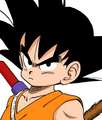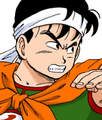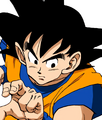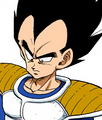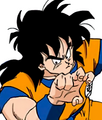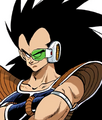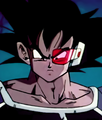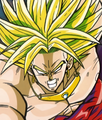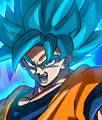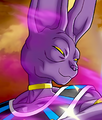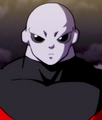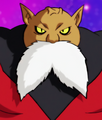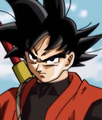The official discord link if you wish to join the discord: https://discord.gg/j5RKwCvAFu
Support the wiki on our official Ko-Fi page or Patreon page!
Dragon Ball
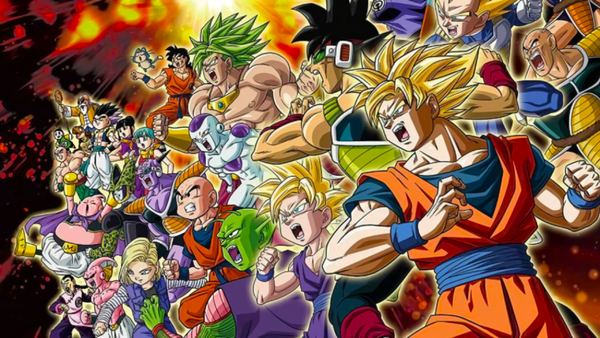
Background
Dragon Ball is an internationally popular media franchise. It consists primarily of a manga series created by Akira Toriyama, five anime series (Dragon Ball, Z, GT, Super and Heroes), twenty anime films, seven anime specials, three live-action films, five anime OVAs, four anime crossovers, two anime PSAs and a high-def remastered recut of Dragon Ball Z. Dragon Ball has an extensive online fanbase and is consistently one of the most frequently searched-for terms on Google, Yahoo! and Lycos. As of January 2012, generating $5 billion in merchandise, Dragon Ball is one of the most merchandisable anime based media franchises of all time.
The story and characters of Dragon Ball were partly inspired by the Chinese folk novel Journey to the West, though they diverge from the novel very quickly. The plot follows the adventures of lead character Son Goku (just simply known as Goku, originally under his Saiyan name Kakarot, and is based on the Monkey King of the folk legend, Sun Wukong) from his childhood through his adulthood. The story includes elements both of action and comedy, though the series became more action-oriented over time.
Terms
- Dragon Balls: Dragon Balls are the namesake artifact of the Dragon Ball series. They are large, crystalline spheres (of varying sizes and colors) that feature five-pointed stars (ranging from one to seven, and also varying in sizes and colors, along with being either rigid or flat in appearance) inside of themselves (akin to glass art); individually, they have no powers, but united they have the ability to call forth their associated Eternal Dragon who can grant (usually) one wish(s).
- Black Star Dragon Balls: A set of Dragon Balls created by a nameless Namekian, long before Kami's creation of Earth's Dragon Balls. This set of Dragon Balls summon Ultimate Sheron, who can grant wishes far more potent than the original Shenron can; such as being able to kill people with a wish. However, as a wish is made on the Black Star Dragon Balls, they spread out across the entire universe, and if they are not returned to the planet the wish was made on in a years time, it will destroy said planet.
- Super Dragon Balls: This set of Dragon Balls were made by the Dragon God, Zalama, which are each the sizes of entire planets. The Super Dragon Balls summon Super Shenron, who dwarves entire galaxies with his size, and can seemingly grant virtually any wish, no matter the severity.
- Super Saiyan: Super Saiyan is an advanced transformation assumed by members and hybrids of the Saiyan race in the Dragon Ball franchise, which was told in ancient Saiyan legend. Earthlings (of Saiyan heritage) in Dragon Ball Online can also assume the transformation by wishing to have their dormant Saiyan powers unlocked. This transformation grants a significant boost to the user's power, and has many evolved and mutated forms; including directly evolutions like Super Saiyan 2 and Super Saiyan 3, and mutated versions like Super Saiyan 4 (accessed through Blutz Waves) and Super Saiyan God (accessed through God Ki.)
Power of the Verse
Dragon Ball is a physically powerful verse due to its main focus on power and strength. With characters starting off the series at Wall level and reaching all the way to Mountain level and Moon level, it’s continuation series Dragon Ball Z ups the power by bringing in Planet level characters all the way to Solar System level characters, the movies and alternate media bring in Multi Solar System level characters and Galaxy level characters, with Dragon Ball Super bringing in Universe level characters due to the introduction of the Gods of Destruction. The video game media goes even further with the power introducing High Multiverse level characters to the mix. In terms of speed the series starts out with Subsonic speed to Supersonic speed though early on reaches High Hypersonic travel speeds with FTL reaction and combat speeds, reaching Massively FTL travel, combat and reaction speeds by the end of Z, with Massively FTL+ by DBS, with games such as Xenoverse and Heroes reaching Extra-Temporal levels of speed.
In terms of hax the verse has abilities such as Transmutation, Mind Manipulation, Existence Erasure, Sealing, Matter Manipulation, Power Nullification, Wish Granting, etc.
Canon
An official Dragon Ball timeline has never been officially revealed, although there are official dates to every major event in the series that could comprise together a major “Dragon Ball timeline.” However, there is still much confusion in the fanbase about what should be considered “canon” and what shouldn’t.
“Canon” in Dragon Ball is an incredibly complex topic that nobody can completely agree on, although the common misconception in the series is that any new material in the series that contradicts old material, should overwrite that old material. This is not the case;
For instance, many people will concede that the original Dragon Ball and Dragon Ball Z manga, written by Akira Toriyama, are the main canon and cannot be overwritten. However, in the end of Dragon Ball Z, Bulma states that she had not seen Goku in five years, which goes against the time placements for Dragon Ball Super.
People will also claim that Dragon Ball Super is more canon than any other material due to the fact that Toriyama himself has worked on it and it is called “canon”; although this is disregarding the fact that Toriyama has also worked on GT, and both Super and GT are seen together on a Dragon Ball history exhibit. To put it bluntly, they are at immense odds with each other.
Thankfully, due to an event seen in Dragon Ball Xenoverse 2, we know that GT and Super are actually alternate timelines to one another, and so you can come to the understanding that they are both equally canon within their own separate branches. The same would go for the Dragon Ball Z anime (which Toriyama also assisted in the creation of, to an extent); anything that goes against the established canon, is an “alternate timeline” of sorts, and anything that doesn’t can be considered supplemental.
Primary Canon
This is material that is considered the main canon, of which every other material is based upon, and cannot be contradicted.
- Dragon Ball: Chapter #1 (Bloomers and the Monkey King) - #519 (Farewell, Dragon World!)
Supplemental Canon
This is material that is not considered to be the main canon due to few contradictions, although it does fit in places. In places where it does not contradict the Primary Canon, it can be slotted in and taken into consideration.
- Toei Animation’s Dragon Ball: Episode #1 (The Secret of the Dragon Balls) - #153 (The End, The Beginning)
- Toei Animation’s Dragon Ball Z: Episode #1 (The New Threat) - #291 (Goku’s New Journey)
- Dragon Ball Z: Bardock – The Father of Goku
- Dragon Ball Z: History of Trunks
- Dragon Ball Z Kai: Episode 1 (Prologue to Battle! The Return of Goku!) - #167 (Even Stronger! Goku’s Dream is Never-Ending!)
Secondary Canon
This is material that cannot co-exist with one another, but can individually be slotted into the Primary Canon, albeit sometimes with a few contradictions. These can be considered alternate timelines.
- Dragon Ball GT: Episode #1 (A Devastating Wish) - #64 (Until We Meet Again)
- Dragon Ball GT: A Hero’s Legacy
- Dragon Ball Super: Episode #1 (The Peace Reward – Who Will Get the 100 Million Zeni?) - #131 (A Miraculous Conclusion! Farewell, Goku! Until We Meet Again!)
- Dragon Ball Super: Broly
- Dragon Ball Super: Super Hero
- Dragon Ball Super: Chapter #1 (God of Destruction’s Premonition) - ???
- Jaco the Galactic Patrolman
- Dragon Ball Minus
- Dragon Ball Films: Movie #1 (Curse of the Blood Rubies) - Movie #4 (Path to Power)
- Dragon Ball Z Films: Movie #1 (Dead Zone) - Movie #15 (Resurrection F)
Note: each Dragon Ball Z film likely each take place in their own separate timelines
Tertiary Canon
This is material that either fits outside of the Primary Canon through means of existing outside of time, is a retelling made for a video game, or is a reboot of the series as a whole. These pieces can either fit in the Primary Canon or not, though they are so far removed that it doesn’t matter. Some of these could thus be considered non-canon.
- Dragon Ball Video Games (ie. Dragon Ball Xenoverse, Dragon Ball FighterZ)
- Super Dragon Ball Heroes: Episode #1 (Goku vs. Goku! A Transcendent Battle Begins on the Prison Planet!) - ???
- Dragon Ball Heroes
- Neko Majin Z
- Dragon Ball Evolution
Knowledgeable Members
Characters
Dragon Ball
Protagonists
-
Kid Goku
-
Yamcha
Antagonists
Dragon Ball Z
Protagonists
-
Son Goku
-
Vegeta
-
Yamcha
Antagonists
-
Raditz
Movie Villains
-
Turles
-
Broly
Dragon Ball GT
Dragon Ball Super
Universe 7
-
Son Goku
-
Beerus
Universe 11
-
Jiren
-
Toppo
Dragon Ball Super (Manga)
Dragon Ball Xenoverse
Dragon Ball Heroes
-
Xeno Goku
Discussions (Link For Mobile Users):
| Discussion threads involving Dragon Ball |
